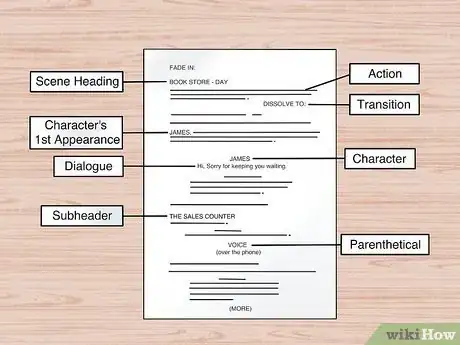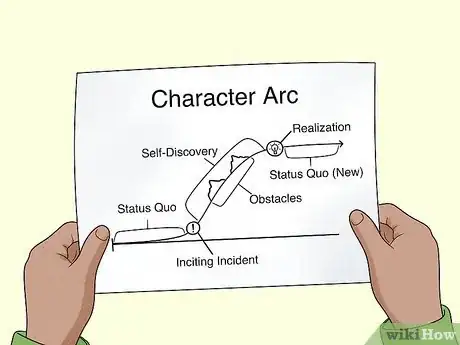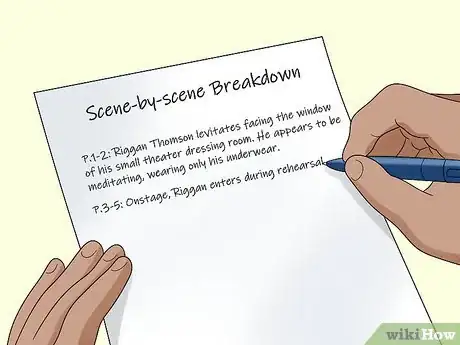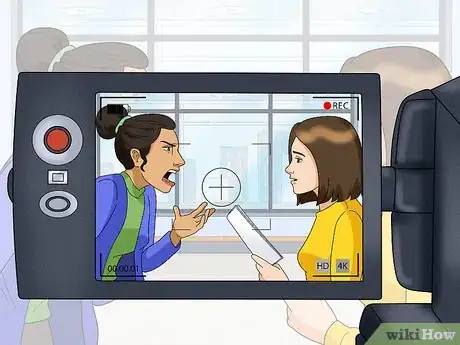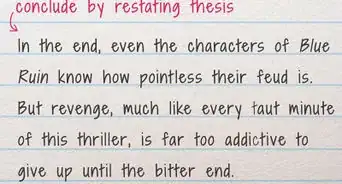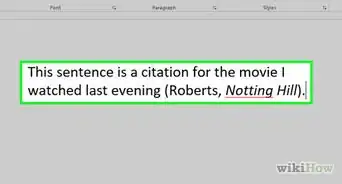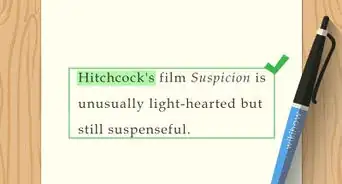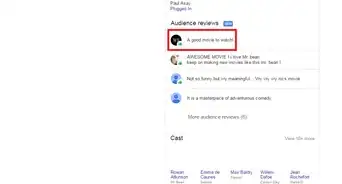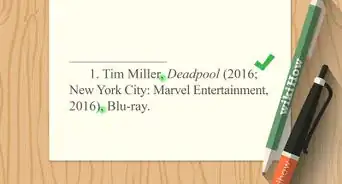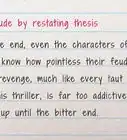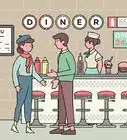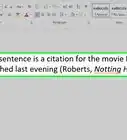This article was co-authored by Melessa Sargent. Melessa Sargent is the President of Scriptwriters Network, a non-profit organization that brings in entertainment professionals to teach the art and business of script writing for TV, features and new media. The Network serves its members by providing educational programming, developing access and opportunity through alliances with industry professionals, and furthering the cause and quality of writing in the entertainment industry. Under Melessa's leadership, SWN has won numbers awards including the Los Angeles Award from 2014 through 2021, and the Innovation & Excellence award in 2020.
This article has been viewed 74,163 times.
In order to make a great movie, you need to have a great script. Screenwriting is an art and reading and dissecting movie scripts will help make you a better screenwriter and film buff. Movie scripts may have their own special formatting, but at the end of the day, a good script consists of interesting characters, plot and arc, just like any other story.
Steps
Understanding Formatting and Story Structure
-
1Become familiar with formatting. Screenplays are formatted differently from books or even stage-plays. Educating yourself on proper screenplay formatting will help you avoid confusion and will allow you to focus on what’s really important: the characters and story.[1]
- The scene heading is the one line description at the top of each scene. This should include the location of the scene, the time of day and whether the scene takes place indoors or outside. This line is also called a “slugline.”
- Any time a character appears for the first time, their name will be written in all capital letters.
- Dialogue is centered in screenwriting and the character’s name appears directly above any dialogue they might say.
- Parentheticals are used to convey a character’s attitude or action. Action can also appear on its own line, to help break up the dialogue between characters.
- In general, there will be a lot more white space when you're reading a movie script as opposed to a book or story.[2]
-
2Look for act breaks. Most movie scripts are written in three-act structure. In three-act structure, the first act serves as your setup, the second act serves as your confrontation and the third act serves as your resolution.[3]
- The first act should introduce the main characters, set up the world they live in and foreshadow the conflict they will encounter during the course of their story. The first act should last approximately 30 pages.
- The second act should escalate the conflict. If at the end of the first act, the hero was sent on a journey, the second act will consist of that journey. Here, your hero will encounter a series of problems and obstacles that have been set up to keep them from achieving their goal. The second act is all about raising the stakes and it should last approximately 60 pages.
- The third act is all about tying up loose ends. In this act, the hero will have their final confrontation and complete their character arc. This is also a chance to answer any final questions left open in the script. The third act should last approximately 30 pages.
Advertisement -
3Study the character arc. In order for a screenplay to be successful, the protagonist needs to change in some way. The change can be as simple as “learning how to love” or “becoming educated,” but they need to leave the movie having changed or grown in some way.[4]
- While reading the script, list all the points where the character grows or evolves. There should be several moments where this occurs in each act, so look closely!
- Any good character should have a clear want or goal they mean to achieve. Note what their goal or want is at the beginning of the script and ask yourself if they got what they wanted in the end. Sometimes character wants or goals change mid-story, so be on the look out for that as well.
Reading Your Script Analytically
-
1Read through the script with an open mind. Find a quiet room with no distractions. Read through the script from start to finish. Quiet your mind so you’re not analyzing the script, you’re just enjoying the story and characters.[5]
- If an observation strikes you during your initial read, write it down and return to it later.
- Avoid taking breaks so you can really get lost in the world of the script.
- If possible, read a hard copy of the script. This way, you avoid the distractions that come with reading on your phone or computer.
- As you're reading, pay attention to whether the writer developed the characters and connected all the storylines in a way that feels complete.[6]
-
2Break the script down scene by scene. After you’ve read the script one time all the way through, go back and read it again. This time, make a list of all the different scenes in the script.[7]
- If scenes are working towards a common event or show a continuous piece of action, group those scenes together.
- Once you have done this, use your scenic breakdown to help you think about the way the movie is structured and to look for patterns and themes within the script.
- Use your scene by scene breakdown to help identify the major plot points and the moments where the narrative is forced in an entirely new direction.
-
3Study the writing style. All writers have different styles and methods for working with language and the same holds true for screenwriters. Comb the script for moments where the writer uses actionable, visual language. Make a list of all the examples you can find. For example, if the writer wrote, “Staggers into a telephone pole,” you would add that to your list.[8]
- Making a list of all the visual writing will help you to really envision the action occurring in the script.
- It will also help you to make your own scripts stronger, if and when you start writing them.
- Try to read a vast array of different screenwriters. The more movie scripts you read, the better you will get at reading, writing and analyzing screenplays.
Reading Your Script With Others
-
1Read the script out loud. The best way to really hear what a script is saying is to read it out loud, preferably with other people. Invite your friends over to do a table read. Have everyone sit in a circle and read the script out loud, together
- Make sure to assign characters so everyone knows what part they are reading for. If you don’t have enough people, ask some actors to double up on smaller roles.
- Remember to assign someone to read the stage directions.
- Make sure to print out enough copies of the script so that everyone has their own.
-
2Put the script on its feet. If you’re feeling particularly ambitious, invite your friends over to perform the script. Have everyone stand at podiums and act the script out from there, or block out the action and dialogue, as if you were performing a play.
- Invite people to come watch the performance. Having an audience will help you to hear and see which parts of the script are resonating the most.
- After you have completed performing the script, ask your friends for their thoughts and feedback. Their ideas may inspire you to see the script in a new light.
-
3Film the script. If you wrote the script or have the rights for the script, try filming a scene or two. In the process of producing the scenes and working with your actors, you are guaranteed to make new discoveries regarding motivations, plot and characters.[9]
- You don’t have to spend a lot of money to film the script. If you don’t have access to fancy equipment, film the scenes on someone’s phone and edit them using iMovie.
- You can usually find people who will be working on your film for free or cheap just for the experience.[10]
- Work with your actors in rehearsal to uncover the motivations behind each line of dialogue and action. Challenge them to make their own discoveries and to not adhere solely to what’s written on the page.
Expert Q&A
-
QuestionHow is a movie script different than a short story?
 Melessa SargentMelessa Sargent is the President of Scriptwriters Network, a non-profit organization that brings in entertainment professionals to teach the art and business of script writing for TV, features and new media. The Network serves its members by providing educational programming, developing access and opportunity through alliances with industry professionals, and furthering the cause and quality of writing in the entertainment industry. Under Melessa's leadership, SWN has won numbers awards including the Los Angeles Award from 2014 through 2021, and the Innovation & Excellence award in 2020.
Melessa SargentMelessa Sargent is the President of Scriptwriters Network, a non-profit organization that brings in entertainment professionals to teach the art and business of script writing for TV, features and new media. The Network serves its members by providing educational programming, developing access and opportunity through alliances with industry professionals, and furthering the cause and quality of writing in the entertainment industry. Under Melessa's leadership, SWN has won numbers awards including the Los Angeles Award from 2014 through 2021, and the Innovation & Excellence award in 2020.
Professional Writer The main difference is the formatting. In a movie script, you want there to be as much white space on the page as possible, whereas in a short story, you'll have paragraphs that are full of description.
The main difference is the formatting. In a movie script, you want there to be as much white space on the page as possible, whereas in a short story, you'll have paragraphs that are full of description. -
QuestionHow do I know when to stop kissing during an acting scene?
 Community AnswerListen to the director. He will offer guidance on how to perform the scene. Also, play by ear. They say "acting is reacting," and it's true! If you've already played the scene up to that point, you should have a feel for the emotions and the motivations behind the kiss. If the scene ends with the kiss, keep going; the ending won't be shown on screen. If it's the very beginning of the scene, end it quickly. Unless it's for humorous effect, don't make it last too long in any one shot.
Community AnswerListen to the director. He will offer guidance on how to perform the scene. Also, play by ear. They say "acting is reacting," and it's true! If you've already played the scene up to that point, you should have a feel for the emotions and the motivations behind the kiss. If the scene ends with the kiss, keep going; the ending won't be shown on screen. If it's the very beginning of the scene, end it quickly. Unless it's for humorous effect, don't make it last too long in any one shot. -
QuestionWhat are the different types of movie scripts?
 Kyle SmuckerCommunity AnswerThe basic types of scripts are, as listed: Action, comedy, drama, fantasy, horror, mystery, romance and thriller.
Kyle SmuckerCommunity AnswerThe basic types of scripts are, as listed: Action, comedy, drama, fantasy, horror, mystery, romance and thriller.
References
- ↑ https://www.writersstore.com/how-to-write-a-screenplay-a-guide-to-scriptwriting/
- ↑ Melessa Sargent. Professional Writer. Expert Interview. 14 August 2019.
- ↑ http://www.elementsofcinema.com/screenwriting/three-act-structure/
- ↑ http://www.scriptmag.com/features/wendys-la4hire-great-screenplay-writing-part-5-character-arc
- ↑ https://gointothestory.blcklst.com/how-to-read-a-screenplay-part-1-the-first-pass-8bc8bfd471f3
- ↑ Melessa Sargent. Professional Writer. Expert Interview. 14 August 2019.
- ↑ https://gointothestory.blcklst.com/how-to-read-a-screenplay-part-1-the-first-pass-8bc8bfd471f3
- ↑ http://gointothestory.blcklst.com/2012/06/how-to-read-a-screenplay-part-7-style-and-language.html
- ↑ http://www.scriptmag.com/features/wendys-la4hire-great-screenplay-writing-part-5-character-arc
- ↑ Melessa Sargent. Professional Writer. Expert Interview. 14 August 2019.
